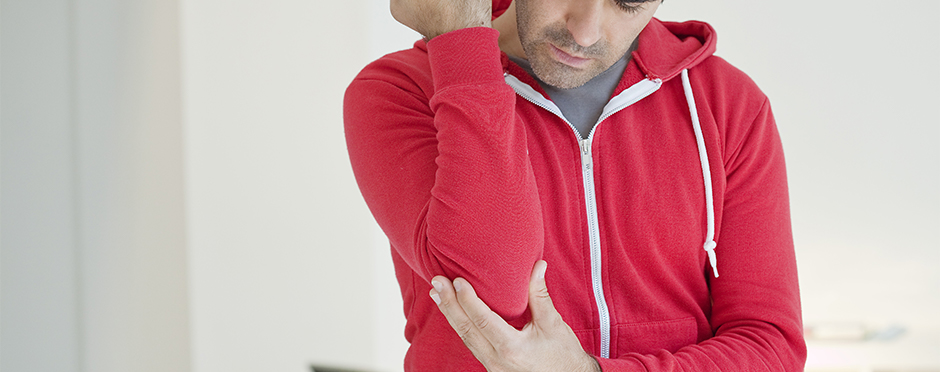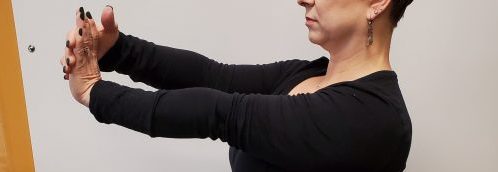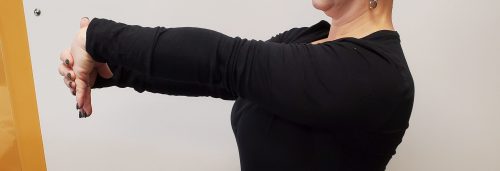
Tips for Tennis and Golfer’s Elbow
2 CommentsYou may have heard of the conditions tennis elbow and golfer’s elbow, but did you know you can suffer from these conditions even if you don’t play either sport? Tennis elbow and golfer’s elbow can occur when there is inflammation, overuse or degeneration of the tendons at the elbow.
Tennis elbow occurs on the outside of the elbow (at the lateral epicondyle bone), and is called lateral epicondylitis or epicondylosis by medical professionals (regardless of whether not you play tennis). Golfer’s elbow, which is known as medial epicondylitis or epicondylosis in the medical world, is a similar condition which causes pain on the inside or medial aspect of the elbow. Pain most often occurs during forceful gripping when the wrist and/or elbow are extended. The condition can be brought on by typical daily tasks that don’t seem too strenuous, such as prolonged carrying and lifting of shopping bags, a laptop computer bag, carry-on luggage, heavy purse or briefcase.
Oftentimes these injures crop up in laborers after prolonged hammering or when sustained gripping is required. Weekend warriors can also experience these symptoms after an uptick in activity when painting, pulling weeds, power washing, using a leaf blower or chainsaw, or other home maintenance and repairs. The source of the pain is where the muscle turns to tendon near its attachment to the bone at the inside or outside of the elbow. The muscle can place a high demand on the tendon, which can be more than it can handle. This causes pain when the tendon becomes injured. Once this becomes irritated it can lead to weakness, where even the simplest tasks such as opening a door, brushing teeth, gripping and turning the steering wheel, or lifting a coffee cup can provoke pain at the elbow. This is typically seen in people over 30, but can occur at any age.
So what can you do if you experience tennis or golfer’s elbow?
- First and foremost, one should avoid any activity that causes or increases painful symptoms.
- Stretch before you complete strenuous tasks or during rest breaks. This can prevent stiffness and maintains muscle length and flexibility. Set a timer on your smartphone to remind you to take a break hourly.
- Perform three sets of each the stretches featured below and hold for 30 seconds at a time, three or more times a day.


Here are Some tips you can incorporate before strenuous tasks at work or during heavy chores:
- Avoid forceful or repetitive wrist motion, such as when using a leaf blower or power washer. Instead turn your body in the direction of the blower or washer. This allows you to use the larger (more efficient) trunk muscles and not the smaller muscles in your forearm.
- Activities with repetitive wrist motion, such as when painting, hammering or washing windows, can also aggravate tennis elbow, so take breaks often or spread the work out over a day or two.
- When moving a mouse for your computer, use your shoulder and elbow to create the movement, instead of using your fingers or wrist.
- Avoid keeping your elbow straight with the wrist extended back, such as when pulling carry-on luggage or a golf bag behind the body, or when riding a bike.
- Choose the correct tools when gardening or completing chores, as this can minimize risk for injury. Use tools with large rubber handles that are easy to grip and hold onto. When pulling weeds, consider using a long weed popper to decrease stress on your forearms and hands. This will improves you mechanical advantage, while decreasing the need to stoop over repetitively.
- When lifting, try to use two hands whenever possible. This spreads the weight over both arms and decreases the amount of work to an injured area. Also keep your palms facing each other or palms under the object, facing up. Holding objects with one hand, such as a bucket or grocery sack handle, can increase the stress on the affected muscles.
- When performing tasks keep the activity as close to your body as possible. This applies to lifting, cooking, typing or handy work.
- Ice may be applied after activity to decrease pain and inflammation.
- Listen to your body. If are you having pain, it’s your body’s way of telling you to take a break or slow down during a repetitive or prolonged activity.
- An over-the-counter wrist immobilization splint can help by avoiding repetitive activity of the inflamed muscles.
When should you seek treatment?
If these tips are not giving you relief, it may be time to contact your physician or schedule an appointment at Athletico. If you have Lateral or Medial Epicondylitis, therapy can help you relieve pain, restore flexibility and strength, while avoiding excessive forces by modifying techniques, equipment or mechanics to decrease symptoms and avoid re-occurrence of symptoms. A therapist can prescribe exercises that allow one to apply the appropriate amount of force, which can help promote tendon healing without increasing pain.
Athletico offers free assessments both in-clinic or virtually through our telehealth platform. Request your free assessment today using the button below.
The Athletico blog is an educational resource written by Athletico employees. Athletico bloggers are licensed professionals who abide by the code of ethics outlined by their respective professional associations. The content published in blog posts represents the opinion of the individual author based on their expertise and experience. The content provided in this blog is for informational purposes only, does not constitute medical advice and should not be relied on for making personal health decisions.
References:
1. Meals, R., (2008) The Hand Owner’s Manual p.104-106.
2. Leadbetter, J., (2006) Hand and Upper Extremity Rehabiliataion, a Practical Guide, Third Edition, p.399-406.
3. Edwards, H., What is Tennis Elbow Lateral Epiconsylosis? Retrieved from https://centerforphysicalexcellence.com/tennis-elbowlateral-epicondylosis/
4. Erickson, J., (2019) Why do I have Tennis Elbow? I don’t play tennis? http://www.raleighhand.com/blog/why-do-i-have-tennis-elbow-i-dont-play-tennis
5. Jones, S., Google tells me it is Tennis Elbow but I don’t play Tennis! Retrieved from https://www.kcbj.com/google-tells-me-it-is-tennis-elbow-but-i-dont-play-tennis/

2 Comments
Maggie Mac Intyre
I am a full tume rancher and I also crop hay and grain and I am wondering if my diagnosed IT Band pain will EVER go away.. 2 years now.. The pain jumps around from the top of my rigjt knee around to the top and sometimes half way down my right tibia and several points front and back of my right side pelvis and sometimes all the way down the outside of my thigh. If is take 400 mg of Ibuprofen every 4-6 hours , I can live with this .. otherwise I can hardly walk or even sleep at night. I read in one of hour blogs that one leg may be shorter and sometimes I think it seems to be my left leg Is shorter so I put peices of felt in all my left boots under the heel. That seemed to help a bit. I am calving out the herds now so I am up and out every four hours 24/7 on rough icey ground at night and mud during the day which is typical in April in Alberta Canada. I spend hours baling hay and straw in late summer and fall and .. thousands of big round bales requiring braking and clutching for each one.. What caused this and PLEASE how do I get rid of it. I am bery strong and very healthy but this is wearing me down.
Athletico
Maggie – We are sorry to hear that your pain has not gone away yet. We would highly recommend finding a good manual physical therapist who can help with differential diagnosis to figure out the root cause of your pain and get you on a solid home exercise program to manage symptoms. They can help determine if your leg length discrepancy is anatomical (in which case heel lift is beneficial) or functional (in which case various manual therapies may be indicated). There may also be an imbalance of tight or weak muscles contributing to continued symptoms, so a good evaluation is needed to assess that. Even though some of your global muscles are strong from your work as a rancher, there are some other smaller muscles that may be weak. Because of the COVID-19 situation, there are a lot more PT providers offering telehealth evaluations.